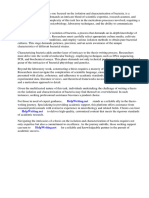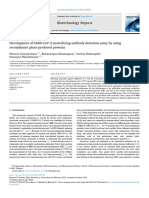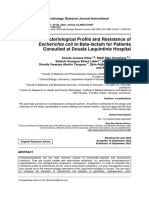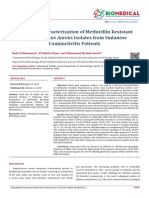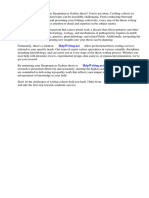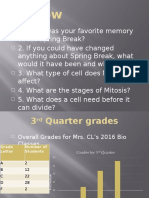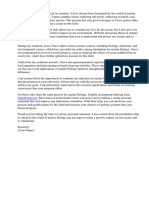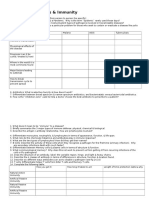Professional Documents
Culture Documents
Isolation and Determination of The Spore - Forming Gene in Pathogenic Bacteria by PCR Technique at The Republican Hospital in Kirkuk
Isolation and Determination of The Spore - Forming Gene in Pathogenic Bacteria by PCR Technique at The Republican Hospital in Kirkuk
0 ratings0% found this document useful (0 votes)
5 views6 pagesThis study focuses on the isolation and
molecular quantification of bacteriostatic genes in
pathogenic bacteria prevalent in the Republican
Hospital in Kirkuk. Spore formation plays a pivotal role
in the virulence and persistence of pathogenic bacteria,
making it essential to understand the presence and
diversity of spore-forming genes in the hospital
environment.
Original Title
Isolation and Determination of the Spore -Forming Gene in Pathogenic Bacteria by PCR Technique at the Republican Hospital in Kirkuk
Copyright
© © All Rights Reserved
Available Formats
PDF, TXT or read online from Scribd
Share this document
Did you find this document useful?
Is this content inappropriate?
Report this DocumentThis study focuses on the isolation and
molecular quantification of bacteriostatic genes in
pathogenic bacteria prevalent in the Republican
Hospital in Kirkuk. Spore formation plays a pivotal role
in the virulence and persistence of pathogenic bacteria,
making it essential to understand the presence and
diversity of spore-forming genes in the hospital
environment.
Copyright:
© All Rights Reserved
Available Formats
Download as PDF, TXT or read online from Scribd
0 ratings0% found this document useful (0 votes)
5 views6 pagesIsolation and Determination of The Spore - Forming Gene in Pathogenic Bacteria by PCR Technique at The Republican Hospital in Kirkuk
Isolation and Determination of The Spore - Forming Gene in Pathogenic Bacteria by PCR Technique at The Republican Hospital in Kirkuk
This study focuses on the isolation and
molecular quantification of bacteriostatic genes in
pathogenic bacteria prevalent in the Republican
Hospital in Kirkuk. Spore formation plays a pivotal role
in the virulence and persistence of pathogenic bacteria,
making it essential to understand the presence and
diversity of spore-forming genes in the hospital
environment.
Copyright:
© All Rights Reserved
Available Formats
Download as PDF, TXT or read online from Scribd
You are on page 1of 6
Volume 9, Issue 2, February 2024 International Journal of Innovative Science and Research Technology
ISSN No:-2456-2165
Isolation and Determination of the Spore -Forming
Gene in Pathogenic Bacteria by PCR Technique at the
Republican Hospital in Kirkuk
Shler Ali Khorsheed
College of Science Kirkuk, University
Abstract:- This study focuses on the isolation and I. INTRODUCTION
molecular quantification of bacteriostatic genes in
pathogenic bacteria prevalent in the Republican Bacterial survival mechanisms in harsh environmental
Hospital in Kirkuk. Spore formation plays a pivotal role conditions often involve the formation of spores, with
in the virulence and persistence of pathogenic bacteria, Gram-positive bacteria, particularly Bacillus and
making it essential to understand the presence and Clostridium species, being known for their proficiency in
diversity of spore-forming genes in the hospital producing endospores .The extremely specialized cellular
environment. Using polymerase chain reaction (PCR) forms known as bacterial endospores enable endospore-
technology, we aimed to develop a targeted and effective forming Formicates (EFF) to withstand extreme
method to detect bacteriostatic genes within bacterial environmental conditions. [1,2 ] .EFF are thought to be
isolates obtained from clinical samples from 200 common in natural settings, especially those that experience
patients of different ages and genders at the Republican stress. Apart from their presence in natural settings, EFF
Hospital. Bacterial isolates were collected from various frequently leads to contamination issues in man-made
clinical sources using standard microbiological locations like hospitals or industrial production units. [3,4].
protocols, and their identification was confirmed Spore-forming bacteria such as Clostridium perfringens
through traditional microbiological methods. Bacillus Bacillus cereus, and Bacillus subtilis have been implicated
subtilis, Clostridium perfringens, Pseudomonas in hospital-acquired infections and nosocomial outbreaks,
aeruginosa Escherichia coli, Streptomyces aureus. primarily through transmission via healthcare workers and
Enterobacter cloacae were isolated from 50% of contaminated surgical instruments [5,6,7]. These spore-
patients. Genomic DNA extraction was performed, and forming bacteria exhibit remarkable resistance to alcohol-
PCR primers were designed to specifically amplify the based disinfectants and various treatments that typically
spore-forming gene region. The resulting PCR products eliminate vegetative cells, including desiccation, heat, UV
were visualized using gel electrophoresis to confirm the and γ-radiation, mechanical stress, chemical exposure,
presence of target genes. The result was the isolation of hydrostatic pressure, and osmotic stress [8,9]. Hence, it is
the .spo0A gene. The study not only aimed to determine imperative to identify these spore-forming bacteria and
the prevalence of spore-forming genes in pathogenic elucidate the genes responsible for spore formation, with
bacteria, but also explored potential associations with spo0A being a pivotal gene involved in endospore
clinical outcomes and antibiotic resistance profiles. In development [10,11]. The ubiquitous presence of the
addition, bioinformatics tools were used to analyze regulatory protein Spo0A is a hallmark of stress-induced
genetic evolution, highlighting the genetic diversity and gene expression machinery and endospore formation
evolutionary aspects of bacteriostatic genes among [12,13]. Molecular tests targeting spore-forming genes can
isolates. This research, conducted at the Republican aid in classifying and characterizing these bacteria,
Hospital in Kirkuk, provides valuable insights into the distinguishing between species with and without
molecular characteristics of pathogenic bacteria in the sporulation genes [14,15]. Previous studies have
healthcare setting. The findings contribute to our determined gene homologs in various bacteria using
understanding of microbial dynamics within hospitals degenerate PCR [16,17]. PCR, a widely used laboratory
and may inform infection control strategies. technique, enables the rapid amplification of specific DNA
Furthermore, the PCR-based approach provides a and RNA sequences, making it invaluable for bacterial
rapid and sensitive diagnostic tool to detect spore- identification and detecting resistance genes [18]. Multiplex
forming genes, facilitating targeted interventions to PCR, an enhanced version, incorporates multiple primers in
mitigate the impact of spore-forming bacteria on patient a single reaction, facilitating the simultaneous analysis of
health. multiple genes and reducing costs and time [19,20,21].
Quantitative PCR (qPCR) is a precise method for
Keywords:- Polymerase Chain Reaction Technique (PCR)- quantifying gene frequencies in DNA extracts [22,23,24].
Spore-Forming Bacteria – Genome- Spo0a Gene. In this study, qPCR primers targeting the spo0A gene were
employed, tested, and validated in pure culture samples
[25,26,27]. In summary, understanding the mechanisms and
genes involved in bacterial spore formation is crucial for
IJISRT24FEB1028 www.ijisrt.com 1224
Volume 9, Issue 2, February 2024 International Journal of Innovative Science and Research Technology
ISSN No:-2456-2165
addressing the challenges spore-forming bacteria poses, .Bacillus the lecithinase test produced negative results,
especially in healthcare settings. Molecular techniques such meaning that lecithinase activity was absent. The isolated
as PCR and qPCR play pivotal roles in this endeavour, colonies were notable for their notable features, which
enabling the identification and characterisation of these included a wrinkled surface on the agar medium, a notable
resilient microorganisms [28]. size, and yellow coloring. As a result of these
distinguishing features, the isolated bacteria were identified
II. METHODOLOGY as Bacillus subtilis , Clostridium perfringens, Pseudomonas
aeruginosa Escherichia coli, Streptomyces aureus.
A. Samples Enterobacter cloacae. Conversely, Mannitol-negative,
This research was conducted in one of Kirkuk's lecithinase-positive, large, flat, and grainy colonies on the
hospitals, which is Kirkuk General Hospital in Iraq, from agar surface were identified as belonging to the Bacillus
January 12, 2023 to 12 of May, 2023. A total of 200 species [32,33].
samples were collected from the wounds of patients who
underwent various surgical operations. D. DNA Extraction:
Characteristic bacterial colonies were selected and
B. Sample Collection: inoculated into a 5 mL Brain Heart Infusion (BHI) solution
Samples were collected by swabbing post-operative obtained from (Sigma-Aldrich, USA). The inoculated
wounds. These collected samples were immediately solution was incubated overnight at 35°C. Subsequently,
transported to the laboratory to ensure their microbial DNA extraction was performed from the cultured solution
integrity. Samples were inoculated onto blood agar, using the (QIA amp DNA mini kit) following the
chocolate agar, and MacConkey agar plates. After that, the manufacturer's instructions for the kit.
plates were incubated for 24 hours at 37°C. After
incubation, observe the agar plates for bacterial growth. E. DNA Quantification:
Isolate individual bacterial colonies by streaking them onto To evaluate the quality of the extracted DNA, agarose
fresh agar plates using the quadrant streak method or a gel electrophoresis was employed, and the concentration of
similar technique To obtain pure cultures, sub-culturing the isolated DNA was assessed at 260 nm using a Nano
streak isolated colonies onto new agar plates. Repeat this drop ND 2000 spectrophotometer from (Thermo Scientific,
process until a pure culture of the spore-forming bacteria is USA). [34,35,36].
obtained. Perform Gram staining and other preliminary
tests to identify the general characteristics of the isolated F. DNA Sequences for Spore Forming Genes:
bacteria. Subject the isolated bacteria to heat treatment To investigate the bacterial genome, particularly
(e.g., 80-85°C for 10 minutes) to induce sporulation. stain focusing on spore-forming genes, we employed primers
the bacterial smears with malachite green or another targeting the 16S rRNA gene, generating fragments of
suitable spore stain and observe under a microscope for the approximately 500 bp. These primers, Eub8f (5'-
presence of spores. Preserve pure cultures of spore-forming AGAGTTTGATCCTGGCTCAG-3') and Eub519r (5'-
bacteria by storing them at -80°C or in appropriate culture GTATTACCGCGGCTGCTGG-3'), were used for this
storage conditions, using a suitable cry protect ant like purpose [37,38 ,39].
glycerol. This protocol provides a basic guideline for
isolating spore-forming bacteria. [29].. In order to identify While the 16S rRNA gene provides phylogenetic
spore-forming bacteria among diverse bacterial species, information about the presence of various bacterial species,
suspected colonies were subjected to a series of we also needed to examine a functional indicator related to
biochemical tests, including catalase production, motility sporulation, specifically the spo0A gene. To achieve this,
assessment, root growth assessment, citrate utilization we utilized primers designed for the spo0A gene. These
reactions, and hemolysis assays. These species primers, spo0A166f (5′-GATATHATYATGCCDCATYT-
identification test procedures are well documented in the 3′) and spo0A748r (5′-GCNACCATHGCRATRAAYTC-
scientific literature [30, 31 ] 3′), were chosen based on their specificity, amplification
efficiency, fragment length, and sequence compatibility
C. Isolation of Spore-Forming Bacteria : with the spo0A gene, which plays a central role in the
The bacterial samples were examined under a spore-forming process [40,41].
microscope due to their Gram stain composition.
Simultaneously, the isolation procedure concentrated on G. PCR Technique:
detecting bacteria exhibiting ethanol resistance, a feature The reaction mixture consisted of 20 µL of Master
frequently linked to spore-forming bacteria. After isolation, Mix (2X) from Thermo Fisher, USA, along with 8.3 µL of
the size of the colony was measured, and a series of tests distilled water, 1 µL (10 µM) of each primer, and 2 µL
was used to distinguish between different kinds of bacteria. (approximately 50 ng) of template DNA. This reaction
The Mannitol test produced positive results, demonstrating mixture was then placed in a thermal cycler programmed
that the bacteria were using Mannitol. On the other hand. for one cycle at 92 °C for 18 minutes, followed by 30
the lecithinase activity of S. aureus is used in detection of cycles of denaturation at 92 °C for 30 seconds, annealing at
coagulase-positive strains, because of high link between 52°C for 30 seconds, and extension at 70°C for 1.5 minutes.
lecithinase activity and coagulase activity. Can be used to Finally, a single extension step at 70°C for 1.5 minutes was
differentiate between certain species within the genus performed. [42].
IJISRT24FEB1028 www.ijisrt.com 1225
Volume 9, Issue 2, February 2024 International Journal of Innovative Science and Research Technology
ISSN No:-2456-2165
The PCR products were subsequently loaded onto a aureus (No 4 no band). , Pseudomonas aeruginosa (No 5
1.5% agarose gel and stained with ethidium bromide no band found), Clostridium perfringens (No 6 band
(ETBR) at a concentration of 0.5 μg/mL for the appeared 608 bp) respectively.
electrophoresis step. The PCR samples were visualized
using an ultraviolet trans illuminator, and the resulting IV. DISSCUTION
bands were analyzed using a gel documentation system for
documentation and analysis. [43,45]. The occurrence of post-operative infections caused by
microbial agents, particularly spore-forming bacteria, poses
The Diagnosis Species were as Follows a significant medical challenge. Addressing this issue
The identified bacterial species in the study included requires effective interventions and increased attention to
Escherichia coli (found in 15 cases), Enterobacter cloacae public hospitals in Iraq. Consequently, the adoption of
(found in 30 cases), Bacillus subtilis (15 cases), accurate techniques, proper procedures, and swift detection
staphylococcus aureus . (14 cases), Pseudomonas methods for identifying infectious microbes from wounds is
aeruginosa (15 cases), and Clostridium perfringens (11 imperative According to studies conducted in 2008 by
cases). Isibor and in 2009 and 2010 by Pradhan, wound infections
happen in hospitals following surgical procedures, and the
Among these identified bacterial species, Bacillus degree of contamination in the wound, where it is located,
subtilis and Clostridium perfringens are well-known for and how long the patient stays there can all affect how well
their spore-forming capabilities. The primers used in this the patient does. [47,48, 46].
study targeted the spo0A gene, recognized as the key gene
responsible for initiating spore formation. The sequencing Polymerase chain reaction (PCR) stands out as a
results confirmed the presence of the spo0A gene in these sensitive, specific, and rapid molecular method extensively
spore- forming bacteria isolated from Kirkuk General employed for detecting microbial species in medical
Hospital [46]., as summarized in Table 1. specimens. In our current study, PCR is indispensable, as it
allows us to target a specific gene, namely the spore-
III. RESULT forming gene.spo0A in bacillus sabtilis and clostridium
perfringes as in the study of Hoon and Krieg in 2010 and
The results indicate that out of the total 200 samples 2009 that within the Firmicutes, endospore formers
analyzed, 100 of them tested positive for bacterial infection, constitute a paraphyletic group [50]. Only the first two
confirming an infection rate of 50% based on the sample classes of this phylum—Bacilli, Clostridia, and
set. The gel electrophoresis results, depicted in (Figure 1), Erysipelotrichi—contain species that generate endospores.
demonstrate the quality of the PCR products. Following the Bacilli are primarily aerobic bacteria, while Clostridia are
subsequent steps of cloning and sequencing, the bacterial primarily anaerobic kinds of bacteria [51].
species were successfully identified.
The majority of our understanding of the biology of
endospore-forming Firmicutes (EFF) has come from
investigations conducted in laboratories using cultivable
strains since the late 19th century [51]. PCR's capabilities
encompass gene extraction, gene sequence comparison, and
determination of a specific gene's presence within bacterial
genomes.
Our examination involved collecting samples from
100 patients with post- operative wounds using cotton
swabs. All collected samples underwent cultivation to
assess the presence of infection as in the study of Qadan in
2009 [52]. The results revealed that 50% of the wounded
individuals were infected, underscoring the urgency of
enhancing the surgical department's attention in public
hospitals each of Niska and Pittet have They have results
close to those of our study [53,54,55].. Various reactions,
such as gram staining (which identifies spore-forming
bacteria as gram-positive) and tests for catalase production,
Fig. 1: Agarose Gel Electrophoresis of PCR-Amplified motility, rhizoid growth, citrate reactions, and hemolysis,
Partial 16S rRNA Genes from Bacteria were conducted to achieve this goal. Subsequently, total
DNA was extracted and employed as a template for
As Lane M represents the DNA ladder , where lanes amplifying the 16S rRNA sequence as in studying both
from 1 to 6 represent the PCR amplified genes for the Madhavan and Jones have results an approach to the results
isolated bacteria , Escherichia coli ( No 1 no band found ) , of this study [56,57, 58]. Additionally, the spo0A gene was
Entrobacter cloacae (No 2 no band found ) , Bacillus targeted to identify spore-forming bacteria within mixed
subtilis ( No 3 band appeared 1000 bp ) Staphylococcus bacterial samples for the protection of regions within the
IJISRT24FEB1028 www.ijisrt.com 1226
Volume 9, Issue 2, February 2024 International Journal of Innovative Science and Research Technology
ISSN No:-2456-2165
16S rRNA gene of bacteria, we utilized globally recognized for regulating spore formation, the spo0A gene. which were
primers this approach considered a group of bacteria Bacillus subtilis , Clostridium perfringens, as shown in the
responsible for infections. Furthermore, we employed study of Anand and Errington in (2001,2000). [59,60].
forward and reverse primers for the master gene responsible
Table 1: Test for Spo0A Amplification through the used Primers
Bacteria Series Temp of Endospore Amplificatio n of Sequences for Spo0a
Optimal Formation Spo0a Gene
Growth
Bacillus subtilis 30 0c Positive Positive sequences
spo0A166f (5′-
GATATHATYATGCC
DCATYT-3′) and spo0A748r (5′-
GCNACCATHGCRAT RAAYTC-3′)
Clostridium perfringens, 30 c0 Positive Positive sequences
spo0A166f (5′-
GATATHATYATGCC
DCATYT-3′) and spo0A748r (5′-
GCNACCATHGCRAT RAAYTC-3′)
Pseudomonas 30 c0 Negative Negative Absent
aeruginosa
Escherichia coli 30 c0 Negative Negative Absent
Staphylococcus areaus 30c0 Negative Negative Absent
Enterobacter cloacae 30 c0 Negative Negative Absent
V. CONCLUSION diseases. Additionally, the findings may have implications
for infection control practices within healthcare settings. In
The isolation and determination of the spore-forming conclusion, the isolation and determination of the spore-
gene in pathogenic bacteria using the Polymerase Chain forming gene using PCR at the Republican Hospital in
Reaction (PCR) technique at the Republican Hospital in Kirkuk represent a significant step forward in advancing our
Kirkuk hold significant implications for understanding and understanding of bacterial pathogenesis. This research has
managing bacterial infections. This sophisticated molecular the potential to inform clinical practices, guide treatment
biology approach allows for the identification and strategies, and contribute to the overall improvement of
characterization of spore-forming genes, providing crucial public health in the region.
insights into the virulence and persistence mechanisms of
pathogenic bacteria. By employing PCR, the researchers can REFERENCES
specifically amplify and detect the spore-forming gene,
enhancing diagnostic capabilities for identifying bacterial [1]. Barbut F, et al.( 2000). Epidemiology of recurrences
strains with increased resistance and survival mechanisms. or reinfections of Clostridium difficile-associated
This information is vital for tailoring effective treatment diarrhea. J. Clin. Microbiol. 38:2386 – 2388.
strategies, as spore formation often contributes to bacterial [2]. Setlow P. (2006). Spores of Bacillus subtilis: their
resilience against conventional therapies. This study resistance to and killing by radiation, heat and
confirmed the success of isolating and diagnosing spore- chemicals. J. Appl. Microbial. 101 514–525.
forming bacteria in certain species and genera of bacteria 10.1111/j.1365- 2672.2005.02736.x
using various traditional diagnostic methods. Pseudomonas [3]. Richardson JF, Reith S. Characterization of a strain of
aeruginosa, Escherichia coli, and Streptomyces aureus were methicillin-resistant Staphylococcus aureus (EMRSA-
diagnosed. Enterobactercloacae, Bacillus subtilis and 15) by conventional and molecular methods. J Hosp
Clostridium perfringens which does not form sepals. Infect 1993; 25: 45–52.
Moreover, the gene responsible for the formation of spores [4]. Labbé R and Hariram U,.( 2015) Spore prevalence
was identified in both Bacillus subtilis and Clostridium and toxigenicity of Bacillus cereus and Bacillus
perfringens was positive as for everyone of Pseudomonas thuringiensis isolates from U.S. retail spices. J Food
aeruginosa, Escherichia coli, and Streptomyces aureus were Prot. Mar;78(3):590-6.
diagnosed. Entero bactercloacae were negative using PCR [5]. Sarker MR Paredes-Sabja D, Raju D, Torres JA,.
technology. The efficiency of PCR in identifying this gene of (2008) Role of small, acid-soluble spore proteins in
this bacterium has been demonstrated through the use of the resistance of Clostridium perfringens spores to
spo0A genetic primers Moreover, this research at the chemicals. Int J Food Microbiol. Mar 20;122(3):333-
Republican Hospital in Kirkuk contributes to the broader 5.
field of microbiology and public health. Understanding the
genetic basis of spore formation in pathogenic bacteria can
aid in the development of targeted therapies, vaccines, and
preventive measures to combat the spread of infectious
IJISRT24FEB1028 www.ijisrt.com 1227
Volume 9, Issue 2, February 2024 International Journal of Innovative Science and Research Technology
ISSN No:-2456-2165
[6]. Sasahara, T., Ae, R., Watanabe, M., Kimura, Y., [20]. Mahbubani M. H., Bej, A. K., and R. M. Atlas.(
Yonekawa, C., Hayashi, S., & Morisawa, Y. (2016). 1991). Amplification of nucleic acids by polymerase
Contamination of healthcare workers' hands with chain reaction (PCR) and other methods and
bacterial spores. Journal of Infection and applications. Crit. Rev. Biochem. Mol. Biol. 26:301–
Chemotherapy, 22(8), 521-525. 334.
[7]. Pittet D, Boyce JM,( 2002). Healthcare Infection [21]. Wagar, E. A. (1996). Direct hybridization and
Control Practices Advisory Committee, Hand Hygiene amplification applications for the diagnosis of
Task Force. Guideline for hand hygiene in health-care infectious diseases. J. Clin. Lab. Anal. 10:312–325
settings. Recommendations of the healthcare infection [22]. Wolcott, M. J. (1992). Advances in nucleic acid-based
control practices advisory committee and the hand detection methods. Clin. Microbiol. Rev. 5:370–386
hygiene task force. MMWR Recomm Rep;51:1e45. [23]. Ehling-Schulz, M.; Knutsson, R. and Scherer, S.
[8]. Allegranzi B,Pittet D, Boyce J, (2009) .World Health (2011): “Bacillus cereus” In: Kathariou S., P.
Organization World Alliance for Patient Safety First Fratamico, and Y. Liu Editors.Genomes of Food- and
Global Patient Safety Challenge Core Group of Water-Borne Pathogens. ASM Press. Washington
Experts. The world health organization guidelines on D.C., USA. 147-164.
hand hygiene in health care and their consensus [24]. Ehling-Schulz, M.; Knutsson, R. and Scherer, S.
recommendations. Infect Control Hosp (2011): “Bacillus cereus” In: Kathariou S., P.
Epidemiol;30:611e22. Fratamico, and Y. Liu Editors.Genomes of Food- and
[9]. Russell AD. (1990) .Bacterial spores and chemical Water-Borne Pathogens. ASM Press. Washington
sporicidal agents. Clin Microbiol Rev; 3:99e119. D.C., USA. 147-164
[10]. Coates Ayliffe, D., G. A. J., and P. N. Hoffman. [25]. Tallent, S.M., Rhodehamel, E.J., Harmon, S.M., and
(1984). Chemical disinfection in hospitals. Public Bennett, R.W. (2012): Bacteriological analytical
Health Laboratory Service, London. manual (BAM); methods for specific pathogens. U.S.
[11]. Piggot PJ, Coote JG.( 1976). Genetic aspects of Food and Drug Administration. Chapter 14 Bacillus
bacterial endospore formation. Bacteriol. Rev. 40:908 cereus.
–962. 2. [26]. Andrade JM, Kubista M, Bengtsson M, Forootan A,
[12]. Stragier P, Losick R. (1996). Molecular genetics of Jonak J, Lind K, Sindelka R, Sjoback R, Sjogreen B,
sporulation in Bacillus subtilis. Annu. Rev. Genet. Strombom L, Stahlberg A, and Zoric N.( 2006). The
30:297–341. real-time polymerase chain reaction. Mol. Aspects
[13]. Hong HA, , Cutting HSM. 2005. The use of bacterial Med. 27:95–125
spore formers as probiotics. FEMS Microbiol. Rev. [27]. Koopman M.J.Mossel D.A., Jongerius E. (2012).
29:813– 835. Abdelaziz, A. A., and M. A. El-Nakeeb. Enumeration of Bacillus cereus in foods. Appl
1988. Sporicidal Microbiol. 1967; 15: 650-653
[14]. Abdelaziz, A. A., and M. A. El-Nakeeb.( 1988). [28]. Errington J. 2003. Regulation of endospore formation
Sporicidal preservatives. activity of local anesthetics in Bacillus subtilis. Nat. Rev. Microbiol. 1:117–126
and their binary combinations with J. Clin. Pharm.. [29]. Stenfors Arnesen, L.p.; Fagerlund, A. and Granum,
13:249-256. P.E. (2008): From soil to gut: Bacillus cereus and its
[15]. Niazi, A.; Manzoor, S.; Asari, S.; Bejai, S.; Meijer, J.; food poisoning toxins. FEMS Microbiol. Rev. 32
(2014) Bongcam-Rudloff, E. Genome analysis of (4):579– 606.
Bacillus amyloliquefaciens subsp. plantarum [30]. Ehling-Schulz, M.; Knutsson, R. and Scherer, S.
UCMB5113: A rhizobacterium that improves plant (2011): “Bacillus cereus” In: Kathariou S., P.
growth and stress management. PLoS ONE, 9, Fratamico, and Y. Liu Editors.Genomes of Food- and
e104651. Water-Borne Pathogens. ASM Press. Washington
[16]. Chauhan, D.K Tripathi, D.K.; Singh, V.P.; Kumar, D.C., USA. 147-164.
D.;. (2012) Impact of exogenous silicon addition on [31]. Tallent, S.M., Rhodehamel, E.J., Harmon, S.M., and
chromium uptake, growth, mineral elements, Bennett, R.W. (2012): Bacteriological analytical
oxidative stress, antioxidant capacity, and leaf and manual (BAM); methods for specific pathogens. U.S.
root structures in rice seedlings exposed to hexavalent Food and Drug Administration. Chapter 14 Bacillus
chromium. Acta Physiol. Plant. , 34, 279–289. cereus.
[17]. Debelius J Sharon G, Garg N, , Knight R, Dorrestein [32]. ,Kotewicz K.M. Strain E.A. Tallent S.M. Bennett
PC, Mazmanian SK. (2014). Specialized metabolites R.W. (2012) Efficient isolation and identification of
from the microbiome in health and disease. Cell Bacillus cereus group. J AOAC Int. ; 95: 446-451
Metab 20:719–730. [33]. Mossel D.A.,Koopman M.J. Jongerius E. (2012).
[18]. Relman DA Dethlefsen L, Huse S, Sogin ML,: (2008 ) Enumeration of Bacillus cereus in foods. Appl
.The pervasive effects of an antibiotic on the human Microbiol. 1967; 15: 650-653.
gut microbiota, as revealed by deep 16S rRNA
sequencing. PLoS Biol, 6:e280. 210.137.
[19]. Marcela Agne Alves Valones, et al (2009).. Principles
and applications of polymerase chain reaction in
medical diagnostic fields: a review .Braz J Microbiol.;
40(1): 1–11.
IJISRT24FEB1028 www.ijisrt.com 1228
Volume 9, Issue 2, February 2024 International Journal of Innovative Science and Research Technology
ISSN No:-2456-2165
[34]. Alejandro M. G. et al,.(2020). Quantification of DNA [49]. Medical Disability Guidelines. Wound infection,
through the Nano Drop Spectrophotometer: postoperative. (2010). Available at:
Methodological Validation Using Standard Reference http://www.mdguidelines.com/woundinfection-
Material and Sprague Dawley Rat and Human DNA. postoperative. Accessed on: June 24,
Hindawi International Journal of Analytical [50]. De Hoon MJL, Eichenberger P, Vitkup D. (2010).
Chemistry Volume 2020, Article ID 8896738, 9 Hierarchical evolution of the bacterial sporulation
pages. network. Curr. Biol. 20:R735–R745.
[35]. N. Sacchi, P. Chomczynski and “Single-step method [51]. D, Krieg NR, Ludwig W, Rainey FA, Schleifer K-H,
of RNA isolation by acid guanidinium thiocyanate – Whitman WB. (2009). Bergey’s manual of systematic
phenol chloroform extraction,” Analytical bacteriology, 2nd ed. Springer, Dordrecht,
Biochemistry, vol. 162, no. 1, pp. 156–159, 1987. Netherlands.
[36]. S. R. Gallagher, “Quantitation of ADN and ARN with [52]. Qadan M, Cheadle WG.( 2009)Common microbial
absorption and fluorescence spectroscopy,” Current pathogens in surgical practice. Surg Clin North
Protocols in Human Genetics, vol. 0, no. 1, pp. Am.;89(2):295–310. vii..
A.3D.1–A.3D.8, 1994. [53]. Centers for Disease Control and Prevention. (2010)
[37]. Finegold S.M Hugenholtz, P. A .Tringe, S.G. (2008); National Center for Health Statistics. National
renaissance for the pioneering 16S rRNA gene. Curr. Hospital Ambulatory Medical Care Survey.
Opin. Microbiol., 11, 442–446. Emergency Department Summary Tables..
[38]. George W.L., Sutter V.L.Citron D.,. (1979) .Selective [2/15/2014]; Available from.
and differential medium for isolation of Clostridium [54]. Niska, R.; Bhuiya, F.; Xu, J. (2010) .National
difficile.J Clin Microbiol. ; 9: 214-219. Ambulatory Medical Care Survey: Emergency
[39]. Woo, P.C.; Lau, S.K.; Teng, J.L.; Tse, H.; Yuen, K.Y. Department Summary. National Center for Health
(2008). Then and now: Use of 16S rDNA gene Statistics; Hyattsville, MD:
sequencing for bacterial identification and discovery [55]. Pittet D. and Boyce JM, (2002). Guideline for hand
of novel bacteria in clinical microbiology laboratories. hygiene in health-care settings: recommendations of
Clin. Microbiol. Infect., 14, 908–934. the Healthcare Infection Control Practices Advisory
[40]. T. E. Meyer. 2002. Evolutionary analysis by Committee and the HICPAC/SHEA/APIC/IDSA
wholegenome comparisons. J. Bacteriol. 184:2260– Hand Hygiene Task Force. MMWR Recomm Rep.;
2272 51(RR-16):1–45.
[41]. Roussel‐Delif, Wunderlin, T., Junier, T., L., Jeanneret, [56]. Madhavan H. N., Anand, A. R., and K. L. Therese.
N., & Junier, P. (2013). Stage 0 sporulation gene A as (2000) . Use of polymerase chain reaction (PCR) and
a molecular marker to study diversity of endospore‐ DNA probe hybridization to determine the Gram
forming F irmicutes. Environmental Microbiology reaction of the infecting bacterium in the intraocular
Reports, 5(6), 911-924. fluids of patients with endophthalmitis. J. Infect.
[42]. Longo, M.C., et al., (1990). Use of uracil DNA 41:221–226.
glycosylase to control carryover contamination in [57]. Jones, J. C,. Cooper, G. M., J. J.. Arbique, G. J.
polymerase chain reactions, Gene, 93, 125-128,. Flowerdew, and K. R. Forward. 2000. Intra and inter
[43]. Sambrook, J. & Russell, D.W. Molecular Cloning, 3 technologist variability in the quality assessment of
rd edition (2001). respiratory tract specimens. Diagn. Microbiol. Infect.
[44]. Kirkpatrick, F.H. Overview of agarose gel properties Dis. 37:231– 235.
.(1991). Electrophoresis of large DNA molecules: [58]. Kumar A, Chen G Wyman TH, Moran Jr CP (2006)
theory and applications 9-22 Spo0A-dependent activation of an extended-10 region
[45]. Kim, Y.H. Citation: Lee, P.Y., Costumbrado, J., Hsu, promoter in Bacillus subtilis. J Bacteriol 188: 1411–
C.Y., (2012) .Agarose Gel Electrophoresis for the 1418.-
Separation of DNA Fragments. J. Vis. Exp. (62), [59]. Errington J (2001) Septation and chromosome
e3923, segregation during sporulation in Bacillus subtilis.
[46]. Galperin MY. and Yutin N, (2013). A genomic update Curr Opin Microbiol 4: 660–666.
on clostridial phylogeny: Gram-negative spore [60]. Madhavan H. N., Anand, A. R., and K. L. Therese.
formers and other misplaced clostridia. Environ 2000. Use of polymerase chain reaction (PCR) and
Microbiol 15:2631–2641. DNA probe hybridization to determine the Gram
[47]. Isibor OJ, Oseni A, Eyaufe A. (2008). Incidence of reaction of the infecting bacterium in the intraocular
aerobic bacteria and Candida albicans in post- fluids of patients with endophthalmitis. J. Infect.
operative wound infections. Afr.J. microbiol. Res. 2: 41:221–226.
288-291
[48]. Pradhan G, Agrawal J. (2009 ).Comparative study of
post-operative wound infection following emergency
lower segment caesarean section with and without the
topical use of fusidic acid. Nepal Med Coll J.; 11:
189-191
IJISRT24FEB1028 www.ijisrt.com 1229
You might also like
- Textbook of Biochemistry With Clinical Correlations 7th Edition 7th Edition Ebook PDFDocument62 pagesTextbook of Biochemistry With Clinical Correlations 7th Edition 7th Edition Ebook PDFfannie.ball342100% (34)
- Biology Science Notebook PDFDocument392 pagesBiology Science Notebook PDFgaja100% (1)
- BIO 1M03 - Chapter 1 NotesDocument2 pagesBIO 1M03 - Chapter 1 NotesUptownsFinest Snapbacks Whole SaleNo ratings yet
- Embriology Hewan - Michael - J. - F. - Barresi - Scott - F. - Gilbert - Developm (B-Ok - Xyz) (2) - 467-490Document24 pagesEmbriology Hewan - Michael - J. - F. - Barresi - Scott - F. - Gilbert - Developm (B-Ok - Xyz) (2) - 467-490Afriani AfidahNo ratings yet
- Tsoktouridis Et Al 2014Document9 pagesTsoktouridis Et Al 2014Francisca Beltrán GuzmánNo ratings yet
- (James W. Snyder, Ronald M. Atlas) Handbook of Med (BookFi)Document542 pages(James W. Snyder, Ronald M. Atlas) Handbook of Med (BookFi)manuelleNo ratings yet
- Isolation and Characterization of Bacteria ThesisDocument8 pagesIsolation and Characterization of Bacteria Thesispatricialeatherbyelgin100% (2)
- Assessment of Different Methods For The Detection ofDocument7 pagesAssessment of Different Methods For The Detection ofOumayma BensalahNo ratings yet
- Antibiotic Resistance Profiles of Pseudomonas Aeruginosa Isolated From Clinical SamplesDocument9 pagesAntibiotic Resistance Profiles of Pseudomonas Aeruginosa Isolated From Clinical SamplesCentral Asian StudiesNo ratings yet
- Isolation and Identification of Bacteria ThesisDocument7 pagesIsolation and Identification of Bacteria Thesisafbtbegxe100% (2)
- Evaluation of The PCR Method For Identification BifDocument7 pagesEvaluation of The PCR Method For Identification Bifu77No ratings yet
- Identification of Pathogenic Bacteria IranDocument8 pagesIdentification of Pathogenic Bacteria Iranfaraz.mirza1No ratings yet
- A Novel Antifungal Therapy: S. Saran AswathamanDocument4 pagesA Novel Antifungal Therapy: S. Saran AswathamanTJPRC PublicationsNo ratings yet
- Foods 11 02282Document12 pagesFoods 11 02282Maria TejedaNo ratings yet
- Modern Methods For Identifying Bacteria: Central Science Laboratory, Sand Hutton, York, Y04 L2, UkDocument2 pagesModern Methods For Identifying Bacteria: Central Science Laboratory, Sand Hutton, York, Y04 L2, UkGalana BiratuNo ratings yet
- Diagnosing: Jericko MagistradoDocument25 pagesDiagnosing: Jericko MagistradoJericko MagistradoNo ratings yet
- Methicillin-Resistant StaphylococcusDocument5 pagesMethicillin-Resistant StaphylococcusAriane Barcellos Dos SantosNo ratings yet
- Phenotypic and Genotypic Characterization of Probiotic YeastsDocument5 pagesPhenotypic and Genotypic Characterization of Probiotic YeastsChi TranNo ratings yet
- Bioactive Molecules From Nocardia: Diversity, Bioactivities and BiosynthesisDocument23 pagesBioactive Molecules From Nocardia: Diversity, Bioactivities and BiosynthesisTika PsbNo ratings yet
- CTS QDs Staphylococus PDFDocument7 pagesCTS QDs Staphylococus PDFLicuriciMarcelaNo ratings yet
- 2023 A Novel Deoxyribonuclease Low-Molecular-Weight Bacteriocin, Carocin S4, Frompectobacterium Carotovorum Subsp. CarotovorumDocument16 pages2023 A Novel Deoxyribonuclease Low-Molecular-Weight Bacteriocin, Carocin S4, Frompectobacterium Carotovorum Subsp. CarotovorumEmonD PhotographyNo ratings yet
- Molecular Typing of Staphylococcus Aureus Isolated From Various Environmental SourcesDocument6 pagesMolecular Typing of Staphylococcus Aureus Isolated From Various Environmental SourcesInternational Journal of Innovative Science and Research TechnologyNo ratings yet
- Preprints202203 0290 v1Document24 pagesPreprints202203 0290 v1Anand KumarNo ratings yet
- Paper-Based PCR Method Development, Validation and Application For Microbial DetectionDocument10 pagesPaper-Based PCR Method Development, Validation and Application For Microbial DetectionshivaniNo ratings yet
- 2 PMID 37992081 BiofilmDocument15 pages2 PMID 37992081 Biofilmajaya basnetNo ratings yet
- Thesis On Isolation of Lactic Acid BacteriaDocument4 pagesThesis On Isolation of Lactic Acid Bacteriadbeadgxff100% (1)
- ajol-file-journals_554_articles_259310_6555de1427089Document6 pagesajol-file-journals_554_articles_259310_6555de1427089Nur ElidaNo ratings yet
- 2022 Article 19844Document12 pages2022 Article 19844raphaNo ratings yet
- Clinical Microbiology and Infection: Y. Huang, B. Yang, W. LiDocument6 pagesClinical Microbiology and Infection: Y. Huang, B. Yang, W. LiFebriyantiNo ratings yet
- Detection of Antibiotic-Resistant Bacteria and Their Resistance Genes in Wastewater, Surface Water, and Drinking Water Bio LmsDocument11 pagesDetection of Antibiotic-Resistant Bacteria and Their Resistance Genes in Wastewater, Surface Water, and Drinking Water Bio Lmsewondo biloaNo ratings yet
- BMS Iddt 2020 41Document8 pagesBMS Iddt 2020 41Guneyden GuneydenNo ratings yet
- 7307 12912 1 SMDocument11 pages7307 12912 1 SMRin ChanNo ratings yet
- Microbiological Laboratory Techniques - Clinical GateDocument18 pagesMicrobiological Laboratory Techniques - Clinical GateCamila Carla CapriglioniNo ratings yet
- MainDocument7 pagesMainmalla ashwiniNo ratings yet
- Laboratory Diagnosis of Infectious Diseases: Alexander J. Mcadam Andrew B. OnderdonkDocument10 pagesLaboratory Diagnosis of Infectious Diseases: Alexander J. Mcadam Andrew B. OnderdonkABHINABA GUPTANo ratings yet
- Guidelinesfor Quick Applicationof Biochemical Teststo Identify Unknown BacteriaDocument19 pagesGuidelinesfor Quick Applicationof Biochemical Teststo Identify Unknown Bacteriara.rodriguezojedaNo ratings yet
- 30395-Article Text-56938-1-10-20220916Document8 pages30395-Article Text-56938-1-10-20220916Djim KARYOMNo ratings yet
- Mechanisms of Bacterial Pathogenicity: ArticleDocument10 pagesMechanisms of Bacterial Pathogenicity: ArticleAnasNo ratings yet
- Bacterial Isolation From Wounds-1Document33 pagesBacterial Isolation From Wounds-1Muneez Hussain HameediNo ratings yet
- Nagy (2018), How To Isolate, Identify and Determine Antimicrobial Susceptibility of Anaerobic Bacteria in Routine Laboratories?Document35 pagesNagy (2018), How To Isolate, Identify and Determine Antimicrobial Susceptibility of Anaerobic Bacteria in Routine Laboratories?Phuong ThaoNo ratings yet
- Main Laboratory Methods Used For The Isolation and Identification ofDocument24 pagesMain Laboratory Methods Used For The Isolation and Identification ofMariaNo ratings yet
- Isolation and Identification of Bacteria That CausDocument6 pagesIsolation and Identification of Bacteria That CausomniyaNo ratings yet
- Notes Related To E.coliDocument6 pagesNotes Related To E.colieeplkol2No ratings yet
- 10 1002btpr 1842Document18 pages10 1002btpr 1842moharryd7No ratings yet
- Emerging Strategies For Microbial Screening of Novel ChemotherapeuticsDocument10 pagesEmerging Strategies For Microbial Screening of Novel ChemotherapeuticsKrish JaiswalNo ratings yet
- Molecular Detection of Virulence Factors (Adhesion Genes) in Some Staphylococcus Epidermidis Locally Isolated From Different Clinical SourcesDocument5 pagesMolecular Detection of Virulence Factors (Adhesion Genes) in Some Staphylococcus Epidermidis Locally Isolated From Different Clinical SourcesKanhiya MahourNo ratings yet
- BJSTR MS Id 005072Document6 pagesBJSTR MS Id 005072z97jxgjpwnNo ratings yet
- IsolationDocument3 pagesIsolationmmak946.lkiNo ratings yet
- BC 7Document8 pagesBC 7Lucky_megaNo ratings yet
- Journal of King Saud University - ScienceDocument5 pagesJournal of King Saud University - ScienceBeshoy RafatNo ratings yet
- Bacteria Isolated From PUS Samples of The Bacteriological Profile and Anti-Biogram in A Secondary Care UnitDocument5 pagesBacteria Isolated From PUS Samples of The Bacteriological Profile and Anti-Biogram in A Secondary Care UnitEditor IJETBSNo ratings yet
- Validation of Biofilm Assays To Assess AntibiofilmDocument7 pagesValidation of Biofilm Assays To Assess AntibiofilmKareem IsmailNo ratings yet
- Sakamoto2006 Molecular Analysis of Bacteria in Asymptomatic and Symptomatic Endodontic InfectionsDocument11 pagesSakamoto2006 Molecular Analysis of Bacteria in Asymptomatic and Symptomatic Endodontic InfectionsElsa Di GiuseppeNo ratings yet
- Natural Products From Nocardia and Their Role in PDocument16 pagesNatural Products From Nocardia and Their Role in PCarlos Augusto Almeida DinizNo ratings yet
- Detection of Integrons in Multidrug Resistant Wound IsolatesDocument7 pagesDetection of Integrons in Multidrug Resistant Wound IsolatesEditor IJTSRDNo ratings yet
- Streptomyces Scabies ThesisDocument5 pagesStreptomyces Scabies Thesisohbmogxff100% (2)
- Methods For The Determination of Limit of Detection and Limit of Quantitation of The Analytical MethodsDocument3 pagesMethods For The Determination of Limit of Detection and Limit of Quantitation of The Analytical MethodsIsis AladaNo ratings yet
- 9140-Article Text-17119-1-10-20200716Document8 pages9140-Article Text-17119-1-10-20200716Maha hameedNo ratings yet
- Assessment of Escherichia Coli Isolates For in Vitro Biofilm ProductionDocument3 pagesAssessment of Escherichia Coli Isolates For in Vitro Biofilm ProductionTëk AñdotNo ratings yet
- Journal of Structural Biology: Contents Lists Available atDocument10 pagesJournal of Structural Biology: Contents Lists Available atDaniel Lopez PernethNo ratings yet
- SBM 2016Document11 pagesSBM 2016Lidwina Faraline TriprisilaNo ratings yet
- Bacillus VelezensisDocument3 pagesBacillus VelezensismstiqueoNo ratings yet
- Project Thesis Ready PDFDocument37 pagesProject Thesis Ready PDFAiswarya V ANo ratings yet
- Recent Progress of Life Science Technology in JapanFrom EverandRecent Progress of Life Science Technology in JapanYoji IkawaNo ratings yet
- Solar Based Multilevel Inverter f o r BLDC Motor DriveDocument8 pagesSolar Based Multilevel Inverter f o r BLDC Motor DriveInternational Journal of Innovative Science and Research TechnologyNo ratings yet
- Unlocking Sentiments: Enhancing IOCL Petrol Pump ExperiencesDocument8 pagesUnlocking Sentiments: Enhancing IOCL Petrol Pump ExperiencesInternational Journal of Innovative Science and Research TechnologyNo ratings yet
- Exploring the Potential Advantages of Traditional Therapies in Autoimmune Blistering Illnesses: A Comprehensive Review and Analysis, ResearchDocument12 pagesExploring the Potential Advantages of Traditional Therapies in Autoimmune Blistering Illnesses: A Comprehensive Review and Analysis, ResearchInternational Journal of Innovative Science and Research TechnologyNo ratings yet
- Smart and Secure Home with ChatbotDocument9 pagesSmart and Secure Home with ChatbotInternational Journal of Innovative Science and Research TechnologyNo ratings yet
- Meta Land: Redefining Virtual Communities through Centralized Governance, Inclusivity and InnovationDocument5 pagesMeta Land: Redefining Virtual Communities through Centralized Governance, Inclusivity and InnovationInternational Journal of Innovative Science and Research TechnologyNo ratings yet
- Seasonal Variation and Distribution Patterns of Endophytic Community in Withania somniferaDocument7 pagesSeasonal Variation and Distribution Patterns of Endophytic Community in Withania somniferaInternational Journal of Innovative Science and Research TechnologyNo ratings yet
- Skin Disease Detection and Remedial SystemDocument7 pagesSkin Disease Detection and Remedial SystemInternational Journal of Innovative Science and Research TechnologyNo ratings yet
- Design and Development of Multi-Featured Medical StretcherDocument4 pagesDesign and Development of Multi-Featured Medical StretcherInternational Journal of Innovative Science and Research TechnologyNo ratings yet
- Global Warming Reduction Proposal AssessmentDocument6 pagesGlobal Warming Reduction Proposal AssessmentInternational Journal of Innovative Science and Research TechnologyNo ratings yet
- Development of Smart Ground Fault Location Model for Radial Distribution SystemDocument14 pagesDevelopment of Smart Ground Fault Location Model for Radial Distribution SystemInternational Journal of Innovative Science and Research TechnologyNo ratings yet
- EmoConnect: Nurturing Trust and Relationship Bonds in Alzheimer’s ConversationsDocument3 pagesEmoConnect: Nurturing Trust and Relationship Bonds in Alzheimer’s ConversationsInternational Journal of Innovative Science and Research TechnologyNo ratings yet
- Preparation and Identification of Magnetic Iron Nanoparticle based on a Natural Hydrogel and its Performance in Targeted Drug DeliveryDocument17 pagesPreparation and Identification of Magnetic Iron Nanoparticle based on a Natural Hydrogel and its Performance in Targeted Drug DeliveryInternational Journal of Innovative Science and Research TechnologyNo ratings yet
- Firm Size as a Mediator between Inventory Management Andperformance of Nigerian CompaniesDocument8 pagesFirm Size as a Mediator between Inventory Management Andperformance of Nigerian CompaniesInternational Journal of Innovative Science and Research TechnologyNo ratings yet
- Application of Plant Growth Promoting Rhizobacteria on Vegetative Growth in Chili Plants (Capsicum frutescens L.)Document7 pagesApplication of Plant Growth Promoting Rhizobacteria on Vegetative Growth in Chili Plants (Capsicum frutescens L.)International Journal of Innovative Science and Research TechnologyNo ratings yet
- Reading Intervention Through “Brigada Sa Pagbasa”: Viewpoint of Primary Grade TeachersDocument3 pagesReading Intervention Through “Brigada Sa Pagbasa”: Viewpoint of Primary Grade TeachersInternational Journal of Innovative Science and Research TechnologyNo ratings yet
- On the Development of a Threat Driven Model for Campus NetworkDocument14 pagesOn the Development of a Threat Driven Model for Campus NetworkInternational Journal of Innovative Science and Research TechnologyNo ratings yet
- PHREEQ C Modelling Tool Application to Determine the Effect of Anions on Speciation of Selected Metals in Water Systems within Kajiado North Constituency in KenyaDocument71 pagesPHREEQ C Modelling Tool Application to Determine the Effect of Anions on Speciation of Selected Metals in Water Systems within Kajiado North Constituency in KenyaInternational Journal of Innovative Science and Research TechnologyNo ratings yet
- Exploring the Post-Annealing Influence on Stannous Oxide Thin Films via Chemical Bath Deposition Technique: Unveiling Structural, Optical, and Electrical DynamicsDocument7 pagesExploring the Post-Annealing Influence on Stannous Oxide Thin Films via Chemical Bath Deposition Technique: Unveiling Structural, Optical, and Electrical DynamicsInternational Journal of Innovative Science and Research TechnologyNo ratings yet
- Osho Dynamic Meditation; Improved Stress Reduction in Farmer Determine by using Serum Cortisol and EEG (A Qualitative Study Review)Document8 pagesOsho Dynamic Meditation; Improved Stress Reduction in Farmer Determine by using Serum Cortisol and EEG (A Qualitative Study Review)International Journal of Innovative Science and Research TechnologyNo ratings yet
- A Study to Assess the Knowledge Regarding Teratogens Among the Husbands of Antenatal Mother Visiting Obstetrics and Gynecology OPD of Sharda Hospital, Greater Noida, UpDocument5 pagesA Study to Assess the Knowledge Regarding Teratogens Among the Husbands of Antenatal Mother Visiting Obstetrics and Gynecology OPD of Sharda Hospital, Greater Noida, UpInternational Journal of Innovative Science and Research TechnologyNo ratings yet
- Application of Game Theory in Solving Urban Water Challenges in Ibadan-North Local Government Area, Oyo State, NigeriaDocument9 pagesApplication of Game Theory in Solving Urban Water Challenges in Ibadan-North Local Government Area, Oyo State, NigeriaInternational Journal of Innovative Science and Research TechnologyNo ratings yet
- Mandibular Mass Revealing Vesicular Thyroid Carcinoma A Case ReportDocument5 pagesMandibular Mass Revealing Vesicular Thyroid Carcinoma A Case ReportInternational Journal of Innovative Science and Research TechnologyNo ratings yet
- Esophageal Melanoma - A Rare NeoplasmDocument3 pagesEsophageal Melanoma - A Rare NeoplasmInternational Journal of Innovative Science and Research TechnologyNo ratings yet
- Detection of Phishing WebsitesDocument6 pagesDetection of Phishing WebsitesInternational Journal of Innovative Science and Research TechnologyNo ratings yet
- Consistent Robust Analytical Approach for Outlier Detection in Multivariate Data using Isolation Forest and Local Outlier FactorDocument5 pagesConsistent Robust Analytical Approach for Outlier Detection in Multivariate Data using Isolation Forest and Local Outlier FactorInternational Journal of Innovative Science and Research TechnologyNo ratings yet
- The Impact of Music on Orchid plants Growth in Polyhouse EnvironmentsDocument5 pagesThe Impact of Music on Orchid plants Growth in Polyhouse EnvironmentsInternational Journal of Innovative Science and Research Technology100% (1)
- Vertical Farming System Based on IoTDocument6 pagesVertical Farming System Based on IoTInternational Journal of Innovative Science and Research TechnologyNo ratings yet
- Sustainable Energy Consumption Analysis through Data Driven InsightsDocument16 pagesSustainable Energy Consumption Analysis through Data Driven InsightsInternational Journal of Innovative Science and Research TechnologyNo ratings yet
- Realigning Curriculum to Simplify the Challenges of Multi-Graded Teaching in Government Schools of KarnatakaDocument5 pagesRealigning Curriculum to Simplify the Challenges of Multi-Graded Teaching in Government Schools of KarnatakaInternational Journal of Innovative Science and Research TechnologyNo ratings yet
- Investigating Non-Newtonian Fluid Behavior in Hydrocyclones Via Computational Fluid DynamicsDocument18 pagesInvestigating Non-Newtonian Fluid Behavior in Hydrocyclones Via Computational Fluid DynamicsInternational Journal of Innovative Science and Research TechnologyNo ratings yet
- Biodiversity and Healthy Society NNDocument63 pagesBiodiversity and Healthy Society NNMarjorie Magayon Blanza100% (4)
- Chapter 14 Ecosystem ADocument15 pagesChapter 14 Ecosystem AIzash AhamedNo ratings yet
- Articulo 2Document77 pagesArticulo 2LIZETTE ESTHER POLO LEALNo ratings yet
- Module 8 MeiosisDocument20 pagesModule 8 Meiosisapi-293001217100% (1)
- Marine Biology Personal StatementDocument40 pagesMarine Biology Personal Statementcjcwrj28100% (1)
- CAPE Biology Unit 1 P1 2017Document12 pagesCAPE Biology Unit 1 P1 2017Sparta100% (3)
- Comprehensive Biotechnology The Principles Applications and Regulations of Biotechnology in Industry Agriculture and MedicineDocument3 pagesComprehensive Biotechnology The Principles Applications and Regulations of Biotechnology in Industry Agriculture and MedicineGareth WealeNo ratings yet
- Pre o Level Science Week 5 - 8 AssignmentDocument5 pagesPre o Level Science Week 5 - 8 AssignmentGuestNo ratings yet
- The Story of The X39: Authors: David Schmidt & Steven Haltiwanger, MD, CCNDocument55 pagesThe Story of The X39: Authors: David Schmidt & Steven Haltiwanger, MD, CCNjanma100% (1)
- ELS11 Q2 Wk1 Thebeginningoflife Ifugao HoggangDocument25 pagesELS11 Q2 Wk1 Thebeginningoflife Ifugao HoggangZack WilliamNo ratings yet
- An Example of A Technical Skills CVDocument2 pagesAn Example of A Technical Skills CVAtique RahmanNo ratings yet
- Dna Finger Printing: Ishita BiswasDocument10 pagesDna Finger Printing: Ishita BiswasISHITANo ratings yet
- The Human Body As An EcosystemDocument2 pagesThe Human Body As An EcosystemMeryville JacildoNo ratings yet
- Modified Crystal Violet Pectate Medium (CVP) Based On A New Polypectate Source (Slendid) For The Detection and Isolation of Soft Rot ErwiniasDocument6 pagesModified Crystal Violet Pectate Medium (CVP) Based On A New Polypectate Source (Slendid) For The Detection and Isolation of Soft Rot Erwinias17L1031038 Nguyen Thi Thuy DuongNo ratings yet
- Plants and Seeds: A 1st Grade Unit On Plants, Seeds, and How They Survive and GrowDocument8 pagesPlants and Seeds: A 1st Grade Unit On Plants, Seeds, and How They Survive and Growapi-337085136No ratings yet
- Histopathology Exam Questions & Answers (Extended MCQ)Document5 pagesHistopathology Exam Questions & Answers (Extended MCQ)Rana Tariq Ejaz100% (1)
- What Is Plant Physiology BOTANYDocument12 pagesWhat Is Plant Physiology BOTANYfatima manzoorNo ratings yet
- Informe Cnio 3013Document248 pagesInforme Cnio 3013espino1956No ratings yet
- 8e6e PDFDocument16 pages8e6e PDFni made dyah gayatriNo ratings yet
- Plant Mineral Nutrition-1Document50 pagesPlant Mineral Nutrition-1All rounders studyNo ratings yet
- Emergent Properties of Individual OrganismsDocument33 pagesEmergent Properties of Individual OrganismsCharleneKronstedtNo ratings yet
- Infectious Diseases & ImmunityDocument2 pagesInfectious Diseases & ImmunityRubban KunaNo ratings yet
- MCQ VirologyDocument4 pagesMCQ Virologymostafaeldeeb2003No ratings yet
- The Potential of Organometallic Complexes in Medicinal Chemistry PDFDocument8 pagesThe Potential of Organometallic Complexes in Medicinal Chemistry PDFArijit dasguptaNo ratings yet
- Vesicular Systems An OverviewDocument13 pagesVesicular Systems An OverviewdianNo ratings yet
- Chapter 6 Cell DivisionDocument20 pagesChapter 6 Cell DivisionVinash Shka RaoNo ratings yet






